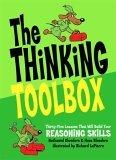
The Thinking Toolbox by Nathaniel Bluedorn and Hans Bluedorn with illustrated by Richard LaPierre is a 35 lesson book on reasoning skills. Each short chapter concludes with exercises to help readers master the content and then can be self-checked against the answers at the end of the book. The chapters cover the big idea of each concept with a simple narrative that illustrates the principle or a context to which it applies. For example when a detective story scenario is developed and you use a skill to solve the mystery. With respect to what thinking/reasoning skills are developed, three areas are covered:
1) “Tools for Thinking” is the section where the elements of reasoning are explained. For example, the contexts for reasoning are illustrated with the distinctions that characterize the difference between a discussion and a disagreement as well as an argument from a fight. The subsequent chapter helps develop discernment with respect the appropriate times to use your reasoning skills (“When It IS Dumb to Argue”). Also the parts of an argument are explained so you can identify what is “doing the work” of an argument or how to construct one. Then tips for building and refining arguments are given.
2) “Tools for Opposing Viewpoints” helps one make decisions, realize that there is always another view, and evaluate the quality of the evidence and its source. Further, this section provides a good beginning to help you discern a motive and various types of evidence.
3) “Tools for Science” introduces basic scientific method. This section demonstrates the need for observation provides some tips and skills. Specifically, the formation of a hypothesis, conducting good experiments, and analyzing the data are each covered well.
Structurally the book is organized and easy to follow, the exercises are good, and the narrative delivery of the content make it an easy to read book.
Why read this book?
Naturally his book will greatly enhance ones abilities for any type of learning (reading, listening, and anything else that requires thought). Beyond this, in a postmodern, ambiguous, most-everything-is-gray-world we live in, we could all use a little clarity of thought. The thinking toolbox (TTB) is a wonderful start in this direction of clarity. The TTB is especially helpful for young people who are currently in school. Its self-directed learning and youth friendly illustrations and exercises bare the touches of the one who knows well the self-teaching format. It is a very accessible book even for adults who might be put off by a college level logic or critical thinking text.
Further, the “real world” applications of good thinking skills are very good. For example in the beginning of the book a man is featured in an illustration that looks suspicious and is trying to pick up a kid. The kid uses the logical thinking skills from the book to figure out that this guy is lying. Although the illustration then takes an unexpected twist, any parent can immediately appreciate this tools provided in TTB. Certainly most adults need to deal with many scams each day. The National Fraud Information Center has enough reported scams going on to merit plenty of critical thinking.
Why might you want to read something else?
If you are an adult or a high school student with natural reasoning skills seeking to move to the “next level,” then you might begin with a more advanced text. Some high school students (and adults) will be put off by the kid-styled illustrations and lack of textual sophistication.
What is my overall opinion of the book?
Great book for kids or if you are looking to build a foundation for good reasoning skills. I think it is a great resource for kids who want to get ahead, learn better or are “home-scholars.” However, if you have attained some sophistication to your reasoning abilities, then get into a logic text or a critical reasoning text.
FYI:
As a Mind & Media reviewer I received this book free from blog for books, and I have not been paid or pushed to rate any particular way. Publishers provide the books in exchange for publicity and reviews. Good Deal eh?
Books
No comments:
Post a Comment